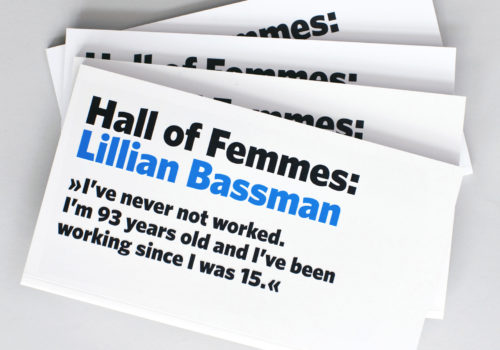At the end of the 1940s, Lillian Bassman was the art director at two of the most influential magazines of all time, Harper’s Bazaar and Junior Bazaar. Though Alexey Brodovitch, Lillian’s teacher and mentor, is usually credited as the sole creator of Junior Bazaar, in fact it was Lillian who designed the magazine.
She began photographing in the late 1940s, and for two decades her work appeared in almost every issue of Harper’s Bazaar, as well as in countless advertisements for high end brands. In the beginning of the 1970s Lillian abruptly lost interest in fashion photography and turned to more personal art projects. She destroyed many of her negatives, but some she boxed up and deposited in an old unheated coal shed behind the house. She continued to shoot commercially and spent two years designing her own fashion line. Over the past few years there has been a Lillian Bassman revival of sorts, and several books and photo exhibitions of her work have popped up around the world.
In the interview book Hall of Femmes: Lillian Bassman the two swedish graphic designers Samira Bouabana and Angela Tillman Sperandio, who works under the name Hjärta Smärta, continue their search for and presentation of female role models. The first book in the serie was on Ruth Ansel and was presented in La Lettre last year (27th of October, 2010).
Here is an extract from the inteview with Lillian Bassman:
Richard Avedon endured 14 canceled meetings before he finally got to work for Harper’s Bazaar. But in Junior Bazaar you gave him the chance to experiment.
He was not well known at all at the time, he had had maybe one page with Harper’s Bazaar. We certainly expected him to grow into what he later became, but at the time he was just Dick Avedon, a little kid, willing and anxious to develop alongside Junior Bazaar. As a matter of fact, Dick and my husband and I, and his wife at the time, shared a cottage at the beach on Fire Island for many years. There were poets, art directors and film directors there. We spent days at the beach planning events and talking about pictures and how to choose. But there was no running water, we’d just pump water and make food on a kerosene stove, so when our first child was born we had to move to a community that had diaper service. We went to another beach, to a civilized place where they had running water ¬ and dull people.
Were there a lot of parties and decadence at the Fire Island house ?
You know, the usual: drinking too much, dancing, too much of everything. It was a marvelous time.
We heard that it was a naturist beach ?
Only one little section. We had a long time introducing Dick to the fact that he could be nude and comfortable. Paul and I were nudist children, it was never a problem for us. With Dick it sort of was a matter of training to get him relaxed enough to run into the water nude.
Are you a restless person?
No, but I can feel like I’ve finished a phase and I’m ready for another one. In the case of Junior Bazaar, it was taken out of my hands. The editor that I loved so much was replaced by a true businesswoman. I took one look at what she was doing and said: »Thank you very
much, I’ll go on to something else.« I was fortunate because I think it was two or three months before the magazine folded. They were going down the drain. They were buying the old way of doing things.
You weren’t interested in moving on to another magazine?
I went up to see Brodovitch and he asked me what I felt like doing. »Why not become a photographer ?«, he said. Fine, I’ll become a photographer. In Junior Bazaar I’d always had a page or two of my own.
Were you familiar with the technique of photography?
No, not a thing. But my husband was a photographer and my job when I helped him was to rinse the film. And while I was at Junior Bazaar, there was a top photographer for Harper’s Bazaar, George Hoyningen-Huene who was away in California. His studio was on the same floor, so during my lunch hour I used to go into his dark room and use his negatives to explore new techniques for printing. I was playing around and learned how to do my own thing. And at one point, Dick went to Paris to shoot the collections, and said: »I’ll be gone for five weeks.Why don’t you take my studio ? Take my assistant, use my equipment, and see what you can do.« By the time Dick came back, I had an advertising account. I was off to the races.
Right after you started as a photographer, you took a picture of Avedon’s wife and child and won an Art Director’s Club award. Have awards meant much to you?
Not very much. I never lacked confidence in myself as a photographer. Maybe wrongly so, but I never picked up the camera without knowing what to do, or feeling what I felt.
Why did you choose to photograph women ? You portray them so intimately.
Well, I did some men, but they never interested me as much. I was thrown into a world of women’s fashion. The men’s fashion magazines were all very dull, with suits and ties. There wasn’t the allure of a beautiful hand or a beautiful throat.
Hall of Femmes: Lillian Bassman
by Hjärta Smärta (Oyster Press)
















